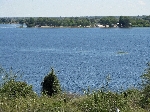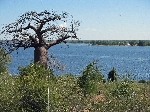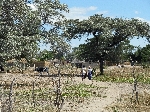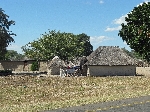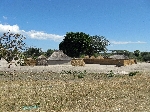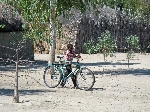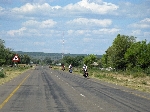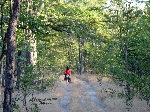Botswana / Namibia:
|
||
Dispatch 2 - Ngoma |
||
|
Nkonga Guest House is a bed and breakfast, so breakfast was included with the room price. We arranged with the staff to have breakfast at 7 AM. We were optimistic when they started cooking at 6 AM, but the meal was actually served at 8 AM. Long preparation times for meals seem to be the rule in Africa. It is still a mystery why it takes so long to boil some water and mix-up some porridge. But it was a meal suitable for a bicyclist when it came! We had one primary task in town before we started immersing ourselves in the rural culture; getting a local cell phone SIM card. It was quick and simple for most of the group, but neither Orange or MTN cards seemed to work in my AT&T Motorola phone. Back to the status quo of the last thirty years for me -- bicycling in Africa without a cell phone. It always worked before, it should work again. The phone went to the bottom of the pack. We were less than ten kilometers out of town when the bicycles were stopped on the highway at the entrance of Chobe National Park. Bicycles are forbidden from riding the 58 km through the park, even at midday on a nice clear day. The explanation we were given is it is an anti-pouching measure and even motor cycles are forbidden. There wasn't much wildlife along this stretch at midday so it can't be much of a safety measure. Because all the vehicles had to stop and be registered, the checkpoint/gate was an easy place to hitchhike. After a couple of asks, four of us got a lift from Ibik Enosi, the CEO of the Botswana National Teachers Union, and the other two grabbed the back of a pick-up truck. Those of us with Enosi had an informative conversation about the state of education in Botswana. Literacy rates are suppose to be 90%. The pick-up saw an a couple antelope-type animals. The Botswana border post is on the south side of the Chobe River. The Namibia border post in on the north side of the Chobe River. Immigrations and customs on both sides of the river were friendly and routine.
For the first time since Kasane (70 km) we came to a store in Ngoma on the Namibia side of the river.
The afternoon and evening were filled with the sounds of the forest. The decibel level rose significantly just before sunset when the birds head to their roosts. Who knows what they are talking, or squawking, about, but they certainly have a lot to say. It is quite a cacophony. Just as the sun set the pandemonium subsides -- all the issues are settled -- and gentler night noises prevail. Crickets and other chirping insects, with the occasional click of a bat, create the background noise that lulled us to sleep. A couple people reported hearing "a large cat screech" nearby at about 1 AM, but I'd like to ignore that. On day two we have our second language: The dominate ethnic group around Ngoma is Chikwahane / Kuhane / Subia or Subiya speaking (multiple names and spellings for the same language): Good morning is "maboka." Good afternoon is "malisala." According to Masubiya oral history, at one time, the Masubiya, along with the Mayeyi (see Sangwali dispatch) and the Mbukushu (see Kongola dispatch) lived together north of the Gcoho Hills. The Masubiya then moved eastwards and settled near the confluence of the Chobe River and the Zambezi River, on the eastern Chobe. The Mayeyi had moved further west. After Lozi expansion of Chief Ngombala (1750), the Masubiya were pushed a short distance south and westwards, by the Mubukushu, onto land that had been vacated by the Mayeyi. Thus Lozi expansionism in the mid to late 18th century created a domino-effect which caused all these people to move further west and south. [The prefix "ma" is very consistent with languages from the Niger-Congo group in southern Africa. It means "the people." For example, Mayeyi is the Yeyi people. The prifix "si" can means language so Siyeyi mean Yeyi language. It gets a little confusing because the prefix can change from language to language, but often the root will remain the same so it is possible to tell what people is being referred to. For example, it seems that the Yeyi people are also referred to Biyeyi and they speak Maiyeyi -- it depends upon the language of the speaker.] The Makololo conquered the whole of this region in about 1838 and controlled it until 1864. |
Addendum: Bayei,
Subiya and Mbukushiu Architecture: |
|
| . | ||
|
||
|
Unique Programs To Special Places For Memories Of A Lifetime!
"Hosted by
DreamHost - earth friendly web hosting"
|
||
|
|
|
